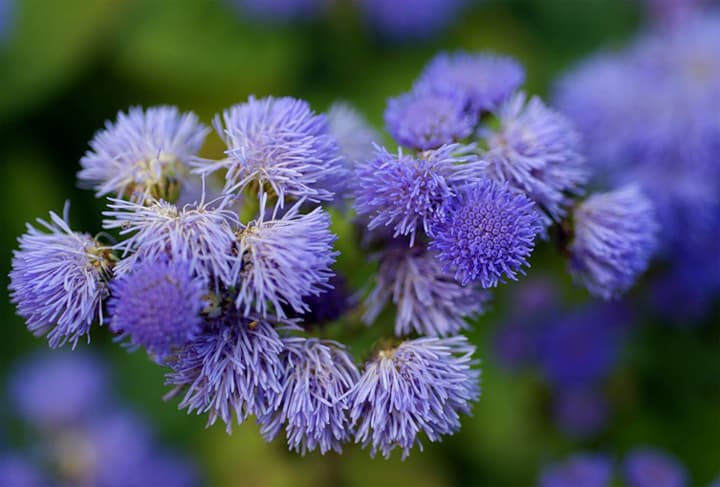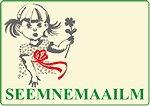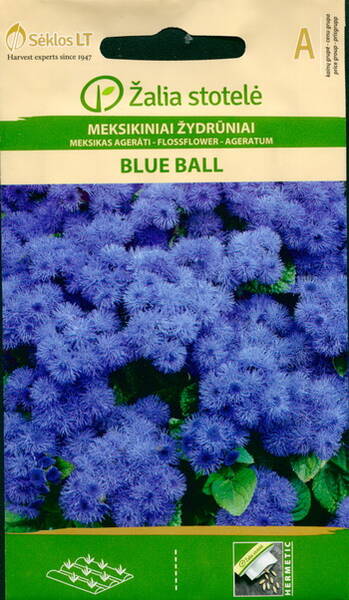Fragrant blue ocean in the flower bed!
This variety of ageratum is excellent as a cut flower. Its fragrant inflorescences exude a pleasant perfume aroma.
Cultivated as an annual.
The plant is upright, branched, up to 60 cm high. Flowering is plentiful from June to frost. Fragrant small blue flowers are collected in dense fluffy inflorescences 5-8 cm in diameter. Quite drought-resistant, light-loving, but can grow with slight shading, prefers light, moderately fertile soils. Heat-loving, does not tolerate frost.
Grow seedlings. Sowing is carried out in late March-early April, seedlings appear after 8-12 days. Planting seedlings in late May-early June, after the end of spring frosts, according to the scheme 20 x 20 cm. They are used for planting in flower beds, in discounts.
1,0 g = 6000-10000 seeds.
Recommended shelf life of seeds: 2-3 years.


Floss-Flower, bluemink, blue billygoat-weed, flossflower. Bot. syn.: Ageratum houstonianum P. Mill.
What is better: to grow seedlings yourself or to buy ready-made ones?
The solution to this question depends on your financial capabilities and love of overcoming difficulties.
Let's consider both sides of the issue. By growing seedlings yourself, you:
♦ save money, since a whole package of seeds costs significantly less (up to 100 times!) than one plant;
♦ can grow rare plants that are not available in industrial and commercial floriculture, as well as delicate plants that do not tolerate transplanting well or do not tolerate it at all;
♦ significantly reduce the risk of introducing pests into your future garden.
But you should remember that the summer in Estonia is not that long (and can be cold), and if you sow seeds in a permanent place in May, then flowering of most plants will not occur before the beginning, or even the middle of July. Some will not have enough time at all to generate buds. This means that in order to get a flowering plant at least in June, you will have to sow in March - April and grow the seedlings at home.
Are you ready to:
♦ fill all the windowsills in the house with pots, bowls and boxes with seedlings?
♦ provide the seedlings with sufficient lighting, arranging additional lighting with lamps?
♦ engage in picking?
♦ protect crops from pets?
If - Yes, then growing seedlings is an activity for you, if Not - leave all these worries to professional gardeners and buy ready-made (often already flowering) seedlings in the spring.
Buying flower seedlings.
In specialized stores, seedlings are sold either with a closed root system (in a pot, plastic bag, etc.), or with an open one (in this case, they are dug out of the box where they grew before your eyes).
Plants with a closed root system are a little more expensive, but they are more viable and "recover" faster after planting, since the roots are not injured again. In addition, they can remain in their containers for quite a long time if for some reason you cannot immediately plant them in a permanent place.
When buying seedlings with an open root system, try not to disturb the root ball too much, do not shake the soil off it and make sure that it does not dry out. Such seedlings need to be planted as soon as possible, but they can also wait a few days before planting if the roots are placed in a plastic bag, leaving a small hole for air. They should be kept in the shade.
Growing flower seedlings.
If you decide to grow seedlings yourself, prepare the necessary dishes (containers) and substrate. Any low boxes, ceramic or plastic bowls, or ordinary flower pots will do as containers.
Substrate - peat mixed with sand in equal parts, or special soil for seedlings from the store. The optimal sowing time is the end of March - beginning of April.
The key to future success is the quality of the seeds. Do not save money by buying questionable seeds from hands - you risk getting zero results. Contact a specialized store.
When buying seeds, inquire about the expiration date. If the package is sealed hermetically, open it immediately before sowing.
So, fill the sowing container with moderately moist substrate almost to the brim, level the surface and compact it slightly. Scatter the seeds evenly over the surface, sprinkle with a thin layer of soil, lightly press down and moisten, preferably with a spray bottle or a watering can with a very fine sieve to prevent erosion.
Small seeds (tobacco, petunia, begonia, poppy, etc.) are mixed with sand (1 part seeds to 10 parts sand) for even sowing and scattered over the surface of the substrate. In this case, they are not sprinkled with soil, but lightly pressed down and moistened.
For faster emergence, you can sow wet and even hatched seeds. The seeds are kept in water or in a weak solution of heteroauxin (root) (0.001%) for 6-24 hours until a saliva-like foam appears, which means the seeds have “awakened”. The swollen seeds are slightly dried so that they do not stick together and immediately sown (when sowing with wet seeds, the shoots appear a few days earlier than when sowing with dry ones).
The seeds are sown. To prevent the substrate from drying out too quickly after sowing, the container is covered with glass or film and placed in a warm place.
The seeds do not need light until the shoots appear, but as soon as they appear (and this will happen in 4-15 days), they should be provided with good lighting (at least 10 hours a day). It is advisable to place the container under an LED daylight lamp, suspended at a height of no more than 25 cm from the shoots. With insufficient lighting, instead of strong seedlings, we will get pale, frail, elongated sprouts. As the seedlings grow, they need to be pricked out - young plants need to be planted out to increase the feeding area. Pricking out is done when the leaves of the seedlings start to touch neighboring plants and growth slows down. This usually happens at the stage of development of the first true pair of leaves.
Using a thin stick, carefully remove the seedling from the ground, pinch the tip of the root (for better development) and plant it in a new container, increasing the distance between the plants by three to four times compared to the previous one. Small seedlings (begonia, petunia, tobacco), which require at least two picks, can be placed closer to each other.
If you do not need a large number of seedlings, then you do not need to pick out the seedlings, but simply thin them out, leaving the strongest plants - with this operation you will also increase the feeding area for the plant. Seedlings can be fed with a weak solution of flower fertilizer, but only if you have provided a good temperature and light regime (temperature not lower than +21°C and lighting 10 hours a day). Fertilizer is applied once every 7-10 days (reduce the dose by half compared to that recommended for adult plants).
Before planting in a permanent place, seedlings must be hardened, first by simply airing the room, then taking the young plants out onto the balcony for a short time, gradually accustoming them to cool air and sunlight. The first two or three days, it is better to keep the seedlings in the shade and only in the following days provide them with access to sunlight for a short time, gradually increasing the time the seedlings spend in the sun. Otherwise, sunburn cannot be avoided, and this, if it does not kill the plants, then, in any case, will greatly slow down their development.
Translated from Greek, "ageratos" means never aging, forever young, long-flowering.
Flossflower easily tolerates pruning and quickly blooms again.
Tip: if there is not enough light, the bush becomes loose and can take on an ampelous shape.












